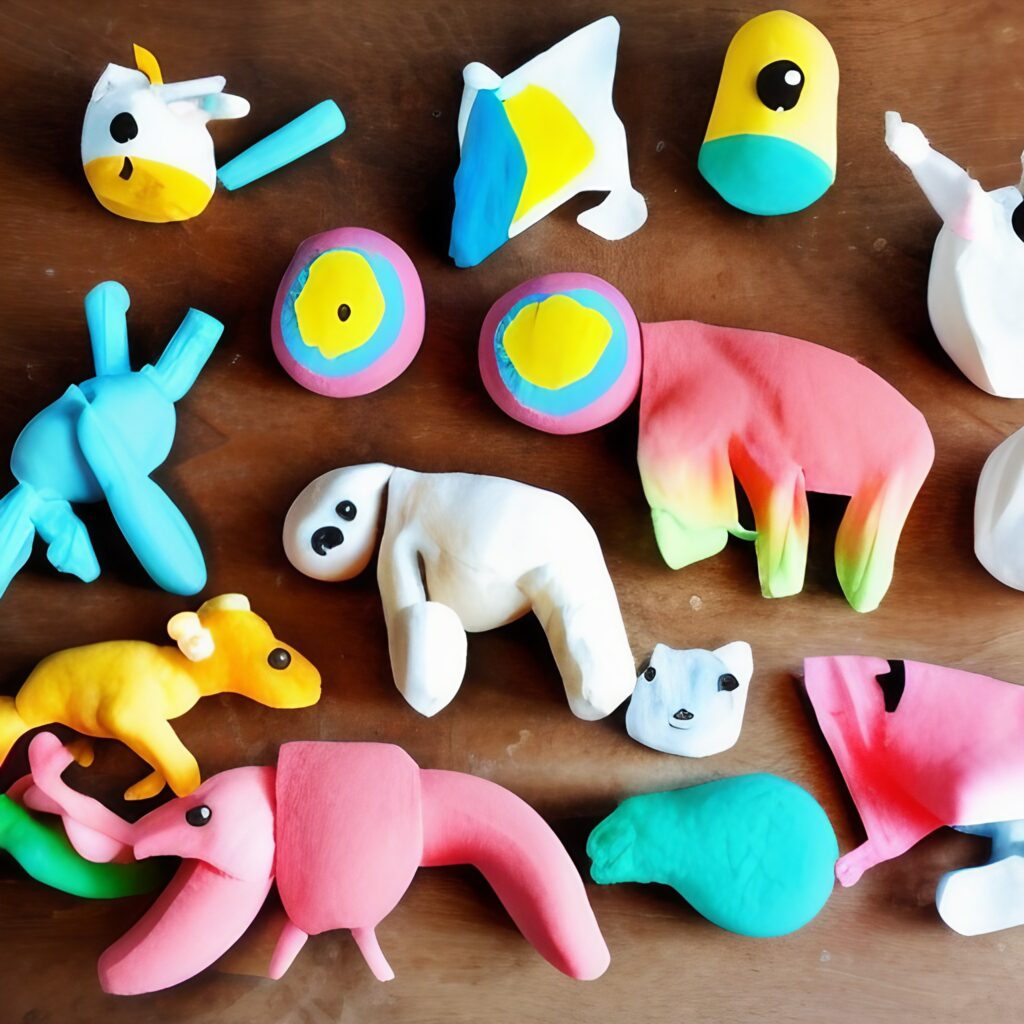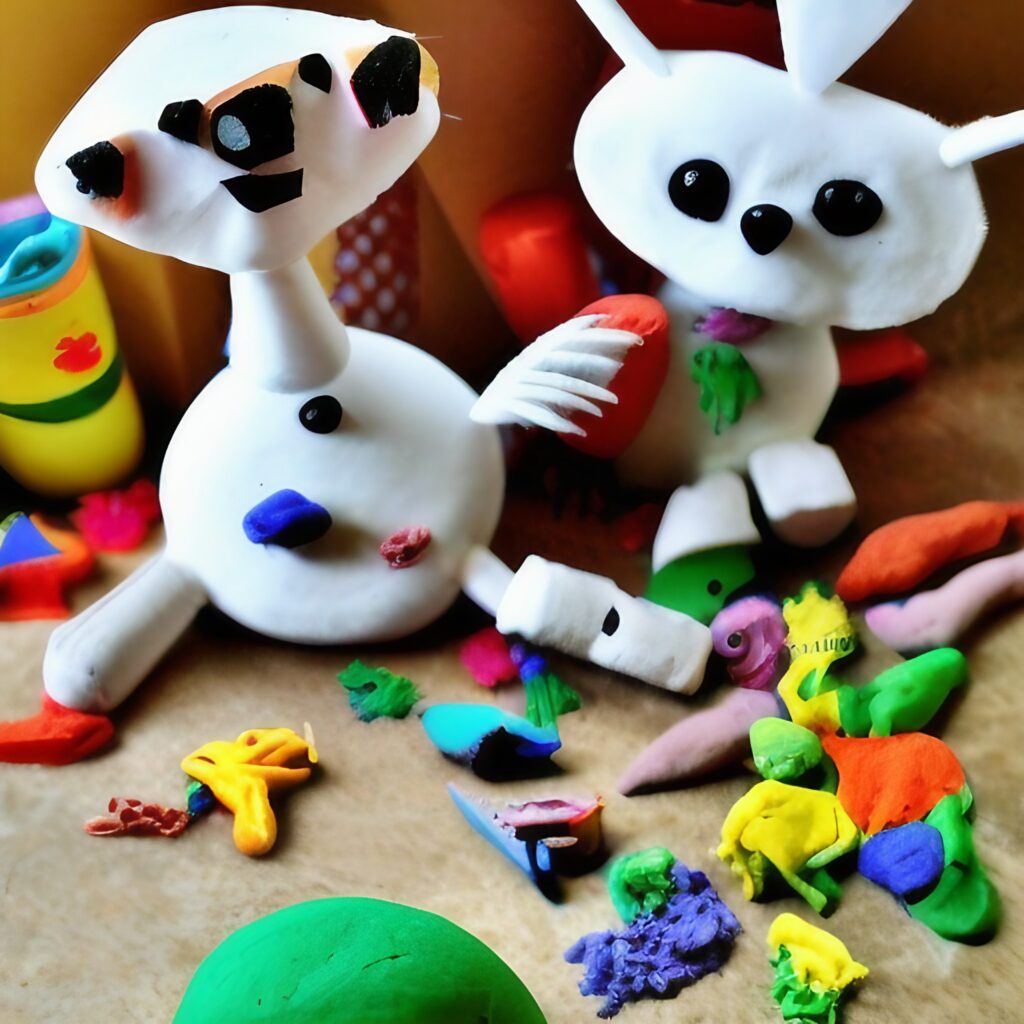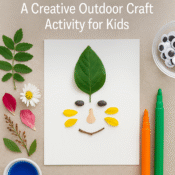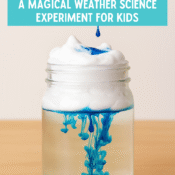
Creative Play: The DIY Playdough Animal Guide
Let’s embark on an exciting journey that awaits when you take your little ones or students on a creative play adventure involving playdough, cookie cutters, and rolling pins! Crafting with playdough not only provides endless fun but also teaches valuable skills like focus, problem-solving, and creativity. The best part? All of this can be done from the comfort of your home.
Whether you are a parent looking for creative activities for your kids or an educator teaching about animals, this DIY Playdough Animal Guide has something for everyone! In this article, we’ll show you how to make your very own animal creations using playdough in easy steps. Let’s dive right in and get creative!

The Materials You’ll Need at Home to Make Playdough Animals
Welcome to the Creative Play DIY Playdough Animal Guide! First things first, here’s a breakdown of all the materials you’ll need to make playdough animals.
To make traditional playdough, you will need:
- 2 cups flour
- 1 cup salt
- 2 tablespoons cooking oil
- 2 cups water
- 2 tablespoons cream of tartar (optional for better texture)
- Food coloring (optional for color variations)
Additional supplies for creating playdough animals:
- Printouts of animal playdough mats (available online)
- Animal cutouts (printed or cut out of cardstock paper)
- Scissors
- Craft glue or hot glue (optional for attaching parts)
- Rolling pins
- Plastic knives
- Cookie cutters in various shapes
- Straws (for detailing)
For making farm animals and vegetables, you might also need:
- Farm animal and vegetable cutouts (printed or cardstock)
- Several craft sticks
Creative Play: The Shapes and Colors Needed to Make Playdough Animals
Ready to get creative? DIY playdough animals are a fun project for kids and adults alike. They are also the perfect medium for exploring shapes, colors, and basic crafting skills.
To make your playdough animals, you’ll need a variety of modeling compounds in different colors. If you opt for a Play-Doh set, they usually come with multiple colors and tools. However, don’t feel limited by these colors; you can always mix various shades to create new hues.
You will also need an assortment of tools like rolling pins to shape the compound; plastic knives to cut it; straws to poke out eyes; cookie cutters in various shapes; and plastic scissors. These tools help children practice identifying, matching, and comparing colors—all essential tasks for young learners.
For those who want to go beyond playdough animals and explore learning activities centered around colors, shapes, numbers, and more, Play-Doh sets often include non-toxic colors with educational playmats. These sets are great for mastering counting skills or recognizing patterns, which can help lay the foundation for math!
Step-by-Step Guidelines to Make Playdough Animals
If you’re ready to give playdough a try, we’re here to help make things easier. Here’s a simple guide on how to make playdough animals from shapes.
Step 1: Gather Your Materials
Collect all the necessary materials listed above, including playdough, tools, and cutouts.
Step 2: Prepare the Dough
Make the playdough using the recipe provided or use pre-made playdough. Divide the dough into smaller portions and add food coloring to each to create different colors.
Step 3: Create Basic Shapes
Use basic shapes such as circles, ovals, and triangles to create the body parts of the animals. For example, you can use a large oval for the body, small circles for the eyes, and elongated shapes for the legs and arms.
Step 4: Assemble the Animals
Combine the shapes to form the animal. Attach smaller pieces to the main body using craft glue if necessary. Use tools like straws to create eyes or other detailed features.
Step 5: Add Details
Enhance your creations with additional details. Use markers to draw patterns or features like stripes for a zebra or spots for a leopard. Add small accessories like ears, tails, or wings made from extra pieces of playdough.
Step 6: Play and Create Habitats
Encourage kids to create different habitats for their playdough animals. They can shape the playdough into mountains, trees, and rivers to give the animals an environment to explore.
By using playdough and shapes to form animals, teachers and parents can create activities that bring out children’s creativity and spark their imaginations. These activities also improve motor skills, problem-solving abilities, and critical thinking.

How to Make an Elephant Out of Playdough
Children love getting creative with playdough, and it’s always fun to make something special out of it. Here’s a step-by-step guide to making an elephant out of playdough—perfect for a rainy day activity with your preschooler.
Step 1: Gather Your Materials
- Two colors of playdough
- Small piece of black construction paper
- Scissors
- Pencil
- Rolling pin
Step 2: Prepare the Dough
Roll out each color of playdough using a rolling pin until both colors are about 1 cm thick. Cut off any uneven pieces or edges with scissors to create two uniform circles (about 10 cm in diameter).
Step 3: Construct the Body and Head
Place the circles side by side on a flat surface. Cut out two small circles (about 5 cm in diameter) from the black construction paper for eyes. Shape the playdough into an elephant by overlapping the circles, using the larger one as the body and the smaller one as the head. Smooth out any irregularities with your fingers.
Step 4: Add Details
Add ears by flattening small pieces of playdough and attaching them to the head. Create a trunk by rolling a small piece into a cone shape and attaching it to the front of the head. Add the black eyes using the cutouts from the construction paper.
Step 5: Enjoy!
Once finished, admire your creation and display it proudly. Encourage your child to customize their elephant further, adding personal touches that make it unique.

Some Famous Playdough Animal Ideas for Kids
Creative play is an essential part of childhood development, and there are countless playdough animal ideas to explore!
Playdough Spider Creating a playdough spider is a simple yet exciting project. Follow a tutorial that requires rolling eight small legs and attaching them to a round body. Kids can then add eyes and fangs for a spooky effect.

Playdough Panda YouTube channels dedicated to playdough crafts offer tutorials for making pandas, octopuses, and whales. These step-by-step guides help kids learn shapes and techniques, making the crafting process educational and enjoyable.
Playdough Crocodile Making a playdough crocodile is easy and fun. Combine round and oval shapes to form the body and head, then add details like scales and eyes. This project is perfect for encouraging creativity and fine motor skills.

Playdough Shark and Octopus Create a playdough shark by shaping a long, pointed body and adding fins. For an octopus, roll out eight tentacles and attach them to a round body. Add eyes and other features to bring these sea creatures to life.
YouTube also has dedicated channels with chapters featuring playdoh animals such as a panda, octopus, and whale. It’s fun to watch tutorials as kids get to learn the shapes and techniques with their own hands. Plus, parents can make the crafting process even more special when they join their kids in creating animals from dough.
Playdough Shark

The Octopus

step by step guide to make playdough at home
Thanks to a few common kitchen ingredients, it’s easy to whip up your own batch of homemade playdough in minutes. Here’s how to do it:
Ingredients:
- 1 cup flour
- 1/2 cup salt
- 2 tablespoons cream of tartar
- 1/2 cup water
- Food coloring (optional)
- Essential oils (optional for scent)
Instructions:
- In a large bowl, mix together flour and salt.
- Make a well in the center and pour in water and cream of tartar.
- Add food coloring and essential oils if desired.
- Knead the dough until it is well combined and smooth.
- Use cookie cutters or plastic knives to cut shapes, or shape it into animals by hand.

Scientific Benefits of Kids Playing With Playdough Animals
Scientific Benefits of Kids Playing With Playdough Animals
Playing with playdough animals offers a wealth of scientific benefits that contribute to various aspects of child development. These benefits span across physical, emotional, social, cognitive, and environmental domains, providing a comprehensive developmental experience for children.
Physical Benefits
Enhances Fine Motor Skills and Hand-Eye Coordination: Manipulating playdough helps children develop fine motor skills, which involve the coordination of small muscles in movements—typically those of the hands and fingers. This activity improves hand-eye coordination as children learn to shape and mold the dough precisely. According to the National Association for the Education of Young Children (NAEYC), activities that involve hand-eye coordination are crucial for the development of skills required for writing, buttoning clothes, and other daily tasks.
Improves Dexterity and Manipulation Skills: Handling playdough requires dexterity, which is the ability to use the hands skillfully. As children roll, pinch, and cut the dough, they enhance their manipulation skills, which are essential for various practical tasks. The repetitive motion of these actions strengthens the muscles in their hands and fingers, preparing them for more complex tasks like using scissors or tying shoelaces.
Strengthens Hand and Finger Muscles: The resistance offered by playdough provides a gentle workout for hand and finger muscles. Regular play helps build strength and endurance in these muscles, which is particularly beneficial for children who may have weaker muscle tone or delayed fine motor development. This strength is vital for tasks that require sustained hand movements, such as writing or playing a musical instrument.
Emotional and Social Benefits
Encourages Emotional Expression and Creativity: Playdough offers a medium for children to express their emotions creatively. They can sculpt figures that reflect their feelings or create scenarios that allow them to work through emotions. This form of play can be particularly therapeutic, providing an outlet for children to manage and express their feelings in a safe and controlled environment.
Promotes Social Interaction and Teamwork: When children engage in playdough activities together, they learn to communicate, share, and collaborate. These interactions promote social skills such as taking turns, negotiating roles, and working as a team to achieve a common goal. According to a study published in the journal “Early Childhood Education,” cooperative play, such as working together to create playdough animals, fosters positive peer relationships and enhances social competence.
Provides a Calming and Therapeutic Activity for Children with Anxiety: The tactile nature of playdough has a calming effect, making it an excellent tool for children who experience anxiety or sensory processing issues. The act of squeezing and molding the dough can reduce stress and provide a sense of control, helping children feel more grounded and focused. Occupational therapists often use playdough in sensory integration therapy to help children regulate their emotions and behaviors.
Cognitive Benefits
Fosters Problem-Solving and Critical Thinking Skills: Creating playdough animals requires children to plan, experiment, and solve problems. They must think critically about how to form different shapes and structures, which enhances their problem-solving abilities. This process encourages them to make decisions, test their ideas, and learn from their mistakes, fostering resilience and adaptability.
Enhances Language and Literacy Through Storytelling and Discussion: As children create playdough animals, they often narrate their actions and invent stories about their creations. This storytelling activity enhances their language and literacy skills by expanding their vocabulary and improving their ability to organize and articulate thoughts. Discussions with peers and adults during playdough activities further reinforce these skills, promoting effective communication.
Encourages Mathematical Concepts Like Counting and Pattern Recognition: Playdough activities naturally incorporate mathematical concepts such as counting, measuring, and pattern recognition. Children may count the legs of a playdough spider, measure the length of a snake, or create patterns with different shapes. These activities provide a hands-on way to explore mathematical ideas, laying a foundation for more advanced math learning.
Environmental Awareness
Sparks Interest in Science and Nature by Modeling Elements from the Natural World: Creating playdough animals can spark a child’s interest in biology and ecology. By modeling animals and their habitats, children learn about different species, their characteristics, and their environments. This hands-on approach to learning science makes abstract concepts more concrete and accessible, fostering a deeper understanding and appreciation of the natural world.
Teaches Children About Different Animals and Their Habitats: As children sculpt playdough animals, they can explore where these animals live, what they eat, and how they behave. This activity can be paired with educational resources such as books or videos to provide a comprehensive learning experience. Understanding the diversity of life on Earth helps children develop a sense of environmental stewardship and the importance of conserving habitats.
Tips for Doing Activities With Playdough Animals
As parents and teachers, here are some useful tips for using playdough animals with kids:
Plan Ahead: Think about the desired outcome and gather all necessary materials in advance. Planning can make the activity smoother and more enjoyable for everyone.
Follow Instructions: Reinforce the importance of following instructions, especially for younger children. This helps them focus and ensures they understand the process.
Be Creative: Encourage creativity by allowing kids to decorate their playdough animals however they like. Use markers, paints, and other craft materials to add unique touches.
Encourage Exploration: Let kids experiment with different shapes and designs. Provide guidance but allow them the freedom to explore their creativity.
Make It Social: Involve other family members or classmates in the activity. Group play encourages social skills and makes the experience more fun.
Jump into Creative Play with Playdough Animals
Creative play is an essential part of a child’s growth and development. Playdough animal activities provide an engaging and educational way to foster imagination, motor skills, problem-solving, and critical thinking.
This guide offers parents and teachers a variety of ways to incorporate playdough animal activities into their routines. Suitable for children of all ages, these activities can help socialize kids and provide endless opportunities for creative expression.
So, get started with these playdough animal activities today—because creative play builds confidence, and it’s never too early to start!






[…] to unleash your child’s inner sculptor with easy play doh animals! This tactile activity is a fantastic way to develop fine motor skills while having oodles of fun. From cute kittens to towering giraffes, the possibilities are endless. […]
[…] you’re hosting a craft session for kids or planning an activity for adults, dino egg crafts offer endless […]